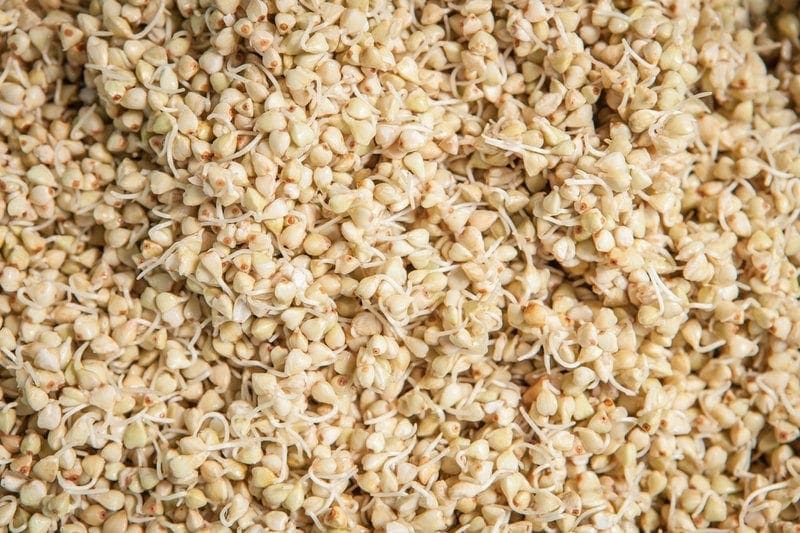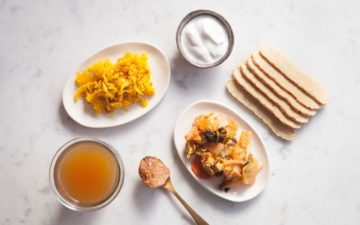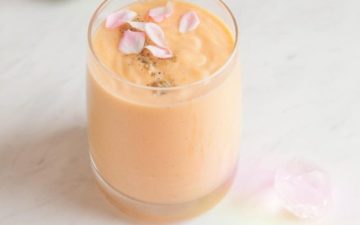Buckwheat is a deliciously versatile, gluten free 'grain'. It's a good source of plant-based protein, minerals and numerous compounds with significant benefits.
Updated July 17th, 2019.

This is part of a series on some of my favourite whole foods - things I consider kitchen staples and use often in my recipes. I hope you get to discover something fun and new about them!
Buckwheat, originally native to Central Asia, is a delicious addition to your whole foods diet, however, it is not a cereal grain, but a fruit seed related to rhubarb and sorrel [1]. The buckwheat plant produces a flower that then leaves behind a seed, referred to as a buckwheat groat. Raw buckwheat groats are triangle shaped and extremely hard. In their natural state, they have a light brown colour. Buckwheat groats may be sold raw, or roasted. Roasted buckwheat is called “kasha” and has a richer, nuttier taste.
The two main varieties available are Fagopyrum esculentum (common buckwheat) and F. tataricum (tartary buckwheat). Buckwheat, as a functional food, has attracted attention for its therapeutic effects in some chronic diseases [2].
[bctt tweet="Buckwheat Nutrition & Health Benefits: a protein packed, low GI, delicious gluten free grain."]
Can you eat buckwheat raw?
Buckwheat groats can indeed be eaten in their raw state, although it may not be so pleasant to ingest them quite as-is. In the context of raw foods, the ideal method of preparation is to soak them first (a process also referred to as ‘activating’), and perhaps even sprout them (pic below - check out the little tails they grow!).
From here, they can be made into a variety of things – for example, you can blend them in the food processor with herbs and spices, nuts and seeds and make a nice raw bread. Soaked buckwheat also makes a fabulous crunchy grawnola once dehydrated. There are many benefits to preparing buckwheat in this way, it enhances the nutty taste, palatability, and makes it easier to digest. Finally, buckwheat groats can be ground into a gritty flour, and this can then be used in various raw foods recipes to impart a grainy, crunchy texture.

How to cook buckwheat
Buckwheat is fabulous cooked, much in the manner you would rice – simply use 1 cup of water to ½ cup of buckwheat, add salt, bring to a boil, reduce to a simmer, and cook till soft (about 25 minutes). It makes a great porridge alternative, risotto, salad, or baked bread. The groats are also sold ground into a flour or as noodles.
Is buckwheat gluten free?
Yes buckwheat is a gluten free grain, and it is safe for coeliacs or those with wheat and gluten allergies [3].
Buckwheat Nutrition Facts
Carbohydrates are the main dietary component of buckwheat. It is a good source of protein (approximately 13%) [4], with nearly twice as much as rice, though not as much as legumes [5]. It contains a small amount of fat, is richer in minerals than it is vitamins and has a good amount of fibre.
Key Macronutrients:
Carbs
Buckwheat is a complex carbohydrate, with a glycaemic index (GI) value of 51 [6]. Foods with a GI value of 55 or less are considered low [7].
GI is a ranking of carbohydrates on a scale of 1 to 100 according to the extent to which they raise the blood sugar after eating. Foods with a high GI are digested, absorbed and metabolised rapidly and consequently cause large fluctuations in blood sugar levels. On the other hand, foods with a low GI are digested and absorbed much slower, resulting in gradual increase in blood sugar and insulin levels. Low GI foods therefore are a better choice for those with both type 1 and type 2 diabetes.
Fibre
Buckwheat is a great source of dietary fibre, with 10g per 100g [8]. Most of us don’t eat enough fibre daily, the recommended daily intake for women is 25g and for men, 30g [9].
Protein
Buckwheat is a good source of protein with 13.2g per 100g [10]. The protein it contains is of a very high quality, the amino acids are well balanced, and rich when compared with other crops [11]. It is particularly high in lysine and arginine [12].
Key Minerals:
Magnesium
Buckwheat is a very good source of the mineral magnesium (231mg per 100g) [13]. Magnesium is required as a cofactor for over 300 essential enzyme reactions in the body. Some of the main actions magnesium is required for include nerve conduction, regulation of vascular tone, muscle activity, synthesis of amino acids and proteins, DNA synthesis and degradation, immune function, energy production, blood clotting, healthy hormonal function and finally as a natural calcium antagonist [14]. Fairly important stuff!
Manganese
Buckwheat is a great source of manganese [15], a mineral involved in the formation of bone. It also plays a role in the metabolism of carbohydrates, cholesterol and amino acids [16].
Phosphorus
Buckwheat is a good source of phosphorus [17], another important mineral in the body, 85% of which is stored in the bone. As phosphate, it is a buffer of acid in the urine, and helps ensure the acid/base balance of the blood [18].
Copper
Buckwheat is a good source of copper [19], which is a component of several enzymes with diverse metabolic roles. Some copper-containing enzymes work as antioxidants, such as superoxide dismutase.
A note on the bioavailability of amino acids and minerals
Studies into the bioavailability of the amino acids and minerals in buckwheat are still ongoing, as this is an area that is not yet well understood. Bioavailability may be compromised, as the seed contains anti-nutrients that interfere with absorption, such as phytic acid, tannins and protease inhibitors [20]. Though, as mentioned eariler, the process of preparing raw buckwheat groats via soaking and sprouting may help to counteract this [21].
Health benefits of buckwheat
There are two stand-out phytonutrients that give buckwheat some pretty special health benefits. These are the flavonoids rutin and quercetin, which enhance the action of vitamin C and act as antioxidants [22]. Another valuable compound is D-chiro inositol, which may be useful in the management of diabetes and polycystic ovarian syndrome (PCOS) [23, 24].
Rutin
Rutin, which is found primarily in seeds, has been shown in studies to be anti-inflammatory and anticarcinogenic, and is more concentrated in the taratary buckwheat, the wilder variety, than common buckwheat. The content in both rapidly increase when buckwheat groats are sprouted [25].
Rutin has been shown in studies to support cardiovascular health. It has a relaxing effect on the blood vessels (and other smooth muscle), so in this way is able to help reduce high blood pressure. It has a lipid-lowering effect, by decreasing the absorption of dietary cholesterol. It has been shown to be highly effective at preventing the formation of blood clots, a cause of heart attacks, strokes, and deep vein thrombosis [26]. Finally, buckwheat also contains the antioxidant vitamin E, high levels of which are associated with a reduction in heart disease [27].
Quercetin
Quercetin has been well studied, it is a potent antioxidant – with 3.5 fold greater antioxidant activity than curcumin (found in turmeric). It is anti-inflammatory, helps lower blood pressure, and is cardioprotective [Braun & Cohen, 2015]. It also has an anti-allergic effect, inhibiting the degranulation of mast cells [Murray, 2013].
D-chiro inositol
D-chiro inositol enhances insulin’s action, consequently lowering blood glucose, decreasing blood pressure and plasma triglycerides. This gives it potential as an adjunctive therapy in treatment of type 2 diabetes and PCOS.
Safety
Some people may have an allergy to buckwheat, and with increasing popularity of this functional food, this may become more common [28].
Summary
- Buckwheat is a gluten-free, low GI pseudo-cereal commonly referred to as a grain
- It has a mild and nutty taste
- It can be eaten raw, preferably soaked and sprouted
- The soaking and sprouting of buckwheat improves its nutrient profile, making nutrients more bioavailable
- Buckwheat is a good source of protein, minerals and fibre
- Two stand-out phytonutrients are rutin and quercetin, which both have cardioprotective effects
- Another compound, D-chiro inositol, helps enhance insulin’s action, and this, combined with its fibre content, makes it a good food choice for those with insulin sensitivity or resistance
- Some people may have a buckwheat allergy, though it is not common
Buckwheat recipes
- Gluten Free Buckwheat Millet Bread
- Creamy Spinach Buckwheat Risotto
- Chocolate Grain-Free Granola
- GF/V Chocolate Cake with Ganache (epic!)




Vlad Dvernik
Thank you! Great article about buckwheat! i eat buckwheat every day and started selling it in NZ now here https://www.baybuckwheat.co.nz